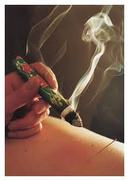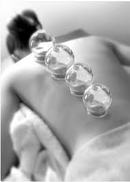ORIENTAL MEDICINE
It is believed that the origins of Oriental Medicine were in ancient China more than 5,000 years ago. From there, it spread throughout the Orient, and each country cultivated a different style of treatment, which has influenced what is taught and practiced in the United States today. Thus, the term Oriental Medicine encompasses Traditional Chinese Medicine (TCM) as well as the practices that grew out of it. At the core of Chinese medical theory is the understanding that we are intimately connected to, and a microcosm of, our external environment, and that the interrelated phenomena and laws of Nature also operate within the human body. These phenomena are understood within the theories of balance and interaction between the energies of Yin and Yang, and the Five Elements of Wood, Fire, Earth, Metal, and Water. Extremes of nature and elements such as Cold, Heat, Wind, Dryness and Dampness can affect our internal environment and cause physiological changes which lead to health problems.
Diagnosis and treatment in Oriental Medicine are based on evaluation of energetic imbalances in the system that lead to manifestation of physical pain or disease. For example, someone may experience increased joint pain during damp weather because their system is vulnerable due to a pre-existing imbalance of Dampness, and thus display symptoms of the disharmony. Oriental Medicine also considers the condition of the Spirit, recognizing that emotions such as sadness, fear, worry, or anxiety can lead to energetic imbalances that manifest as dis-ease.
Diagnosis and treatment in Oriental Medicine are based on evaluation of energetic imbalances in the system that lead to manifestation of physical pain or disease. For example, someone may experience increased joint pain during damp weather because their system is vulnerable due to a pre-existing imbalance of Dampness, and thus display symptoms of the disharmony. Oriental Medicine also considers the condition of the Spirit, recognizing that emotions such as sadness, fear, worry, or anxiety can lead to energetic imbalances that manifest as dis-ease.
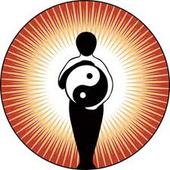
Evaluation of a syndrome considers both the cause, mechanism, location, and nature of the disharmony, as well as the interaction between a pathogenic factor and the body resistance. Treatments have a wide range of intentions, including: strengthening the body’s life force, releasing a pathogen, or regulating the flow of energy through the body. Treatment is based on both the presenting symptoms, and the underlying root imbalance. Therefore, two people with an identical disease may be treated in different ways because the root cause is different, and on the other hand, different diseases may be due to a similar root cause, and are thus treated in similar ways.
In addition to an understanding of Chinese medical philosophy, the practice of Oriental Medicine rests upon interpretation of physical and emotional signs and symptoms through asking, listening, observing, and palpating to identify root causes of disharmony. Thus, a practitioner inquires about aspects of a patient's lifestyle and tendencies including: diet, digestion, sleep, thirst, sweating, emotions, pain, and energy levels, as well as cardiovascular, genito-urinary, and respiratory patterns. The practitioner listens to the sound of the voice and observes the color and lustre of a patient's skin, nails, hair, and face, the tone and shape of the body. The tongue is an important diagnostic tool, as the color, shape, and coating of the tongue all reflect the internal condition of the body and different areas of the tongue correspond directly to areas of the body. Information is also obtained through palpation of the body, the belly, and the twelve pulses in the wrists, each representing a different organ system, and as a whole, indicating the general health of the patient.
Oreintal Medicine includes the use of a wide range of modalities including Acupuncture, Herbology, Moxibustion, Cupping, Gua Sha, Tuina (Chinese medical massage), Energetics (Qi Gong) and Dietetics (Nutrition).
In addition to an understanding of Chinese medical philosophy, the practice of Oriental Medicine rests upon interpretation of physical and emotional signs and symptoms through asking, listening, observing, and palpating to identify root causes of disharmony. Thus, a practitioner inquires about aspects of a patient's lifestyle and tendencies including: diet, digestion, sleep, thirst, sweating, emotions, pain, and energy levels, as well as cardiovascular, genito-urinary, and respiratory patterns. The practitioner listens to the sound of the voice and observes the color and lustre of a patient's skin, nails, hair, and face, the tone and shape of the body. The tongue is an important diagnostic tool, as the color, shape, and coating of the tongue all reflect the internal condition of the body and different areas of the tongue correspond directly to areas of the body. Information is also obtained through palpation of the body, the belly, and the twelve pulses in the wrists, each representing a different organ system, and as a whole, indicating the general health of the patient.
Oreintal Medicine includes the use of a wide range of modalities including Acupuncture, Herbology, Moxibustion, Cupping, Gua Sha, Tuina (Chinese medical massage), Energetics (Qi Gong) and Dietetics (Nutrition).
ACUPUNCTURE
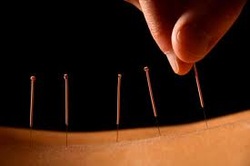
Acupuncture is the use of very thin disposable sterile stainless steel needles to stimulate points along pathways called meridians to regulate the flow of Qi (vital energy) through these channels and stimulate the body's healing process. When a needle is inserted, patients may feel nothing or sensations of a slight sting, dullness, warmth, electricity, tingling, or heaviness. Most patients feel very relaxed during the treatment and often fall asleep. Acupuncture helps to balance the flow of Qi through the channels and all of their pathways, their related organs, and associated spiritual qualities.
Qi can become blocked, deficient or excess due to a variety reasons including trauma, overwork, poor dietary and exercise habits, or stress, and this imbalance may lead to disharmony and pain. Through stimulation of acupuncture points, Qi flows more smoothly, carrying vital energy and Blood through the meridians to organs and areas in need of healing. Acupuncture is used to treat a wide variety of internal, external, and emotional conditions including muscular tension, arthritis, pain, immunity, skin conditions, stress, fertility, and digestive, respiratory, circulatory, and reproductive conditions. The number of treatments that each patient needs to address specific health concerns varies depending on factors including the duration and severity of the symptoms and the patient's constitution. Acupuncture is also used preventatively and for maintenance of vital health.
Qi can become blocked, deficient or excess due to a variety reasons including trauma, overwork, poor dietary and exercise habits, or stress, and this imbalance may lead to disharmony and pain. Through stimulation of acupuncture points, Qi flows more smoothly, carrying vital energy and Blood through the meridians to organs and areas in need of healing. Acupuncture is used to treat a wide variety of internal, external, and emotional conditions including muscular tension, arthritis, pain, immunity, skin conditions, stress, fertility, and digestive, respiratory, circulatory, and reproductive conditions. The number of treatments that each patient needs to address specific health concerns varies depending on factors including the duration and severity of the symptoms and the patient's constitution. Acupuncture is also used preventatively and for maintenance of vital health.
HERBOLOGY
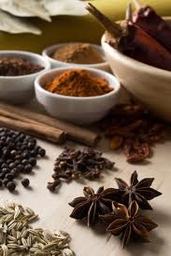
Herbs have been used throughout history in China to treat every condition from common cold and digestive disorders to endometriosis and cancer. There are thousands of herbs in the Chinese pharmacopoeia and they are used singly and in hundreds of combinations to restore balance and health in body, energy, and Spirit. Herbs include the roots, leaves, and flowers of plants as well as minerals and various animal parts. Herbal formulations take the form or teas, powders, pills, tinctures, and syrups. Typically, there are one or two herbs in the formula said to have the greatest effect on the problem being treated, while the other ingredients treat more minor aspects, direct the formula to certain parts of the body, and help the other herbs work more efficiently. Determination of which formula is prescribed for a patient is based on presenting symptoms and signs, underlying root causes, and the patient's constitution.
Scientific research has revealed extensive information about the chemical constituents of individual herbs and formulas proving them to be anti-viral, anti-inflammatory, immune stimulating, and fertility enhancing, to name a few qualities. In addition, there has been extensive research regarding herb-drug interactions between Chinese herbs and Western pharmaceuticals. Several Chinese herbs have been found to have toxic components and others have been classified as endangered species, and these herbs are generally no longer in use. A few herbs may produce allergic reactions in patients, as would a food. The formula prescribed to a patient is often adjusted throughout the course of treatment as the patient's symptoms and health change.
Scientific research has revealed extensive information about the chemical constituents of individual herbs and formulas proving them to be anti-viral, anti-inflammatory, immune stimulating, and fertility enhancing, to name a few qualities. In addition, there has been extensive research regarding herb-drug interactions between Chinese herbs and Western pharmaceuticals. Several Chinese herbs have been found to have toxic components and others have been classified as endangered species, and these herbs are generally no longer in use. A few herbs may produce allergic reactions in patients, as would a food. The formula prescribed to a patient is often adjusted throughout the course of treatment as the patient's symptoms and health change.
GUA SHA, TUINA, ENERGETICS, DIETETICS
Gua Sha is a technique whereby the skin is scraped using a spoon or other tool with the intention of bringing red dots/petechiae to the surface to help release blockage from areas of stagnation. This technique is often used when a patient presents with pain and muscle tension associated with either an acute or chronic disorder. In addition to resolving musculo-skeletal pain, Gua Sha is used to prevent and treat common cold, asthma, bronchitis, and any other disorder involving pain and blockage.
Tuina is a hands-on treatment that aims to bring the body into balance through touch. It includes techniques of brushing, kneading, rolling, pressing, rubbing, traction, range of motion, and manual pressure on acupuncture points to stimulate the flow of Qi and Blood through the meridians and muscles, open the body, and enhance healing.
Energetics include Qi Gong, which can be both practiced by the practitioner on the patient, and by the patient for themselves. There are many forms of Qi Gong and within Chinese Medicine it is used both preventatively and curatively. In Medical Qi Gong, the practitioner affects and directs Qi (vital life force) with the mind or hands or voice, but without necessarily touching the body. The intentions may include: regulating Qi flow, reducing pain, moving blockage, and strengthening organs and/or areas of weakness. In addition, Qi Gong exercises will be recommended for the patient to practice at home, to continue to cultivate and regulate Qi. These exercises may be dynamic, static, or meditative including visualizations, sounds, and breathing practices.
Dietetics is an important part of Chinese Medicine, as every food has a Yin or Yang quality, as well as a specific temperature, and taste (spicy, bitter, salty, sweet, acrid). Therefore, the inclusion or exclusion of specific foods will help heal the body into balance, and maintain health. Depending on what the patient is experiencing, certain foods may be recommended to avoid as they will exacerbate the condition, while others will be encouraged to mitigate the symptoms and balance the constitution. For example, a person who is experiencing hypertension (too much Yang) will be advised to avoid Yang foods such as fried food, pork, alcohol, and sweet foods, and to increase the amount of Yin foods including vegetables and steamed rice.
Tuina is a hands-on treatment that aims to bring the body into balance through touch. It includes techniques of brushing, kneading, rolling, pressing, rubbing, traction, range of motion, and manual pressure on acupuncture points to stimulate the flow of Qi and Blood through the meridians and muscles, open the body, and enhance healing.
Energetics include Qi Gong, which can be both practiced by the practitioner on the patient, and by the patient for themselves. There are many forms of Qi Gong and within Chinese Medicine it is used both preventatively and curatively. In Medical Qi Gong, the practitioner affects and directs Qi (vital life force) with the mind or hands or voice, but without necessarily touching the body. The intentions may include: regulating Qi flow, reducing pain, moving blockage, and strengthening organs and/or areas of weakness. In addition, Qi Gong exercises will be recommended for the patient to practice at home, to continue to cultivate and regulate Qi. These exercises may be dynamic, static, or meditative including visualizations, sounds, and breathing practices.
Dietetics is an important part of Chinese Medicine, as every food has a Yin or Yang quality, as well as a specific temperature, and taste (spicy, bitter, salty, sweet, acrid). Therefore, the inclusion or exclusion of specific foods will help heal the body into balance, and maintain health. Depending on what the patient is experiencing, certain foods may be recommended to avoid as they will exacerbate the condition, while others will be encouraged to mitigate the symptoms and balance the constitution. For example, a person who is experiencing hypertension (too much Yang) will be advised to avoid Yang foods such as fried food, pork, alcohol, and sweet foods, and to increase the amount of Yin foods including vegetables and steamed rice.
